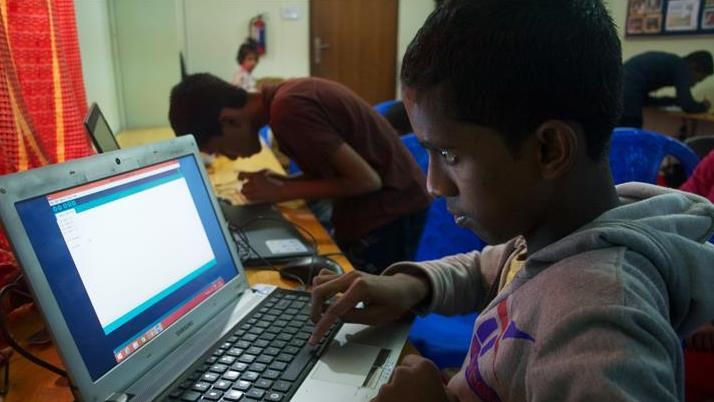

By Anadolu Agency
GENEVA
The first global connectivity forum of Giga — a joint initiative between UNICEF and the International Telecommunication Union (ITU) which aims to connect every school worldwide to the internet by 2030 — is set to take place in Geneva on Tuesday.
The initiative, launched in 2019, includes 34 countries. For the first time, representatives from these countries are gathering at the two-day global forum to share experiences and discuss the initiative’s progress.
“We currently have 34 countries around the world that are active in Giga, meaning they’ve agreed to be part of the Giga community at the government level,” Alex Wong, a senior strategy advisor of ITU and Giga co-lead, told Anadolu in an interview.
The forum includes participants from 25 of these countries, including seven ministers: four ministers of education and three ministers of Information Communication Technology from Benin, Lesotho, Niger, Botswana and Zimbabwe, Wong added.
He said there are around 6 million schools globally, but it is hard to be sure about the exact number.
“Because of outdated data or lack of infrastructure,” most national governments do not know where all schools are, he said.
He noted that only half of that figure has “some level of connectivity,” highlighting the need for targeted efforts to connect schools in rural and underserved areas.
Asked how possible it is to connect at least three million schools in less than six years, he said: “It’s very ambitious to get to 2030 to have every school connected, but that’s our goal.”
Infrastructure alone needs almost a trillion dollars
Responding to how much it would cost to connect every school, Wong cited a recent study that ITU is working on, with estimates “on the infrastructure alone of almost a trillion dollars.”
This could include fiber, wireless, towers and satellite solutions, he added.
He also said that Giga doesn’t have a specifically targeted region for this goal as it aims to achieve global connectivity. However, he said “the biggest need” is going to be the developing countries in the list of Giga nations — a combination of low and really low-income countries and also kind of middle-income countries.
That is why the initiative has no program in Western Europe or the US, he said.
Regarding funding, he said that Giga is in a “fine” position this year, and added that Giga’s immediate goal is to secure enough funding to maintain its operations and support its global centers.
“This year, financially, we’re fine thanks to support from key donors like the Swiss and Spanish governments,” he said.
He said Giga’s tools and methodologies are open source, allowing any country to use them to polish its present connectivity infrastructure.
Methodology
Wong underlined that Giga’s approach to the global connectivity of schools involves a comprehensive methodology: mapping, modeling, financing and contracting.
“Mapping means identifying where every school is,” he said, adding that this step is “crucial,” as many countries lack up-to-date data on school locations.
He added that the Giga maps, which indicate connectivity status with color codes, are a cornerstone of this effort.
On the financial aspect, he said the initiative is multifaceted and involves blended finance and innovative approaches like connectivity credits.
“We’re exploring things like connectivity credits,” he said, comparing it to carbon credits, where entities get rewarded for connecting rural areas.
He said that contracting is “another key component” aiming to leverage market transparency and bulk purchasing to reduce costs.
“Contracting sounds boring, but it’s procurement and negotiating contracts,” he noted, emphasizing the potential for cost reduction through strategic contracts.
Data sharing ‘crucial’
According to Wong, sharing data openly is a “crucial” call to action for countries involved in Giga.
“One of the first things we ask is to make your data open,” he said.
He underlined that open data not only enables lower costs but also fosters innovative solutions.
Countries like Brazil have set a “positive example” by making their connectivity data public, allowing for “greater collaboration and innovation,” he said.
“Brazil has been a role model,” he noted, highlighting their use of spectrum auctions to fund school connectivity.
He also said that Giga benefits from the extensive reach of the UN system, with UNICEF and the ITU having offices in numerous countries. He said this network ensures continuous support and interaction with local ministries and technical teams.
“One of the keys to our success is the UN’s extensive presence,” he said, as this collaborative approach ensures that Giga’s goals align with broader educational and connectivity initiatives.
Ensuring political support at the highest levels is “crucial” for Giga’s success, he emphasized and said that it aims to keep school connectivity a priority on the global agenda, supported by heads of state and ministers of finance.
“One of our deliberate strategies is to make sure this stays at a head-of-state level agenda,” he said.
He noted that Giga is opening a new global connectivity center in Geneva this year, complementing the Barcelona Tech Center launched in 2023. He added that these centers serve as hubs for the community to gather, share ideas and develop solutions.
We use cookies on our website to give you a better experience, improve performance, and for analytics. For more information, please see our Cookie Policy By clicking “Accept” you agree to our use of cookies.
Read More